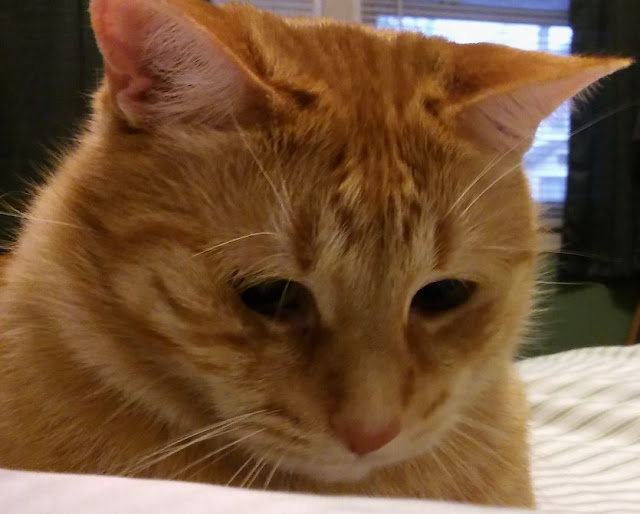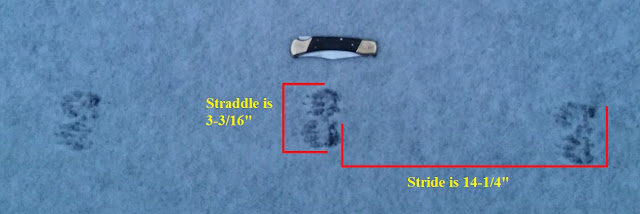The size of the tracks, their gait and stride length,
but most importantly their straddle can tell you a lot about who made the
tracks. A Guide to Nature in Winter:
Northeast and North Central North America, Donald W. Stokes
Do you like forensic crime shows? What about detective stories? I do, and here is one that took place in my
driveway.
It was early spring, it had snowed that morning,
stopping at first light, leaving about ¼ inch of snow behind. I let my cat out the back door at 5:30 am, it
was overcast and still dark outside, and the sun was just starting to peak over
the horizon. A few minutes later, my cat
was back at the door, meowing loudly to come in. When I opened the back door, he was already
standing on the second step and when I opened the screen door, he charged in as
if all of the hounds of hell were hot on his trail! Definitely not usual behavior for him, he
usually wants to stay out for thirty minutes or more and he usually waits
inside the open shed, that we call a garage, to be let in.
It was trash day, a Monday, and I was outside at first
light to drag the wheelie-bins up my driveway to the street, when I realized I
had, had visitors last night. Who could
they be, I wondered, who had left their calling cards stamped up and down my
driveway? What were they doing? Was it a
cat, a coyote, a neighbor’s dog…? Since,
I had to be at work soon, I had to be happy with taking some pictures, tossing
my Roger Tory Peterson Field Guide to Animal Tracks, into my workbag and
hopping into my car.
The first set of tracks I found were on the top of my
back steps and were simple to identify. They
were 1-1/3 inches long and wide and I could tell right away that they were cat
tracks. In fact, I could tell that the
cat that had left the tracks was an overweight, orange tabby tomcat, who is
about five years old. This last bit was
a cheat, though, because when I had opened the door to let my cat, Copper, into
the house I had seen him leave the tracks on the back step.
My cat Copper. Picture by the Author.
All joking aside, how did I know right away that these
were cat tracks? Several things
distinguish cat tracks from dog tracks.
The first clue is whether there are claw marks or not. Canine tracks usually display claw marks,
while cat tracks do not. Canine tracks
tend to be oval, and are longer from heel to toe than they are wide; while cat
tracks are round and are as long as they are wide. Additionally, cat tracks often display a
leading toe, which is a toe that sticks out further than the rest, while with
dog tracks the two front toes are side by side.
Also, the heel pads of cats are larger than the small, two lobed,
triangular pads of dogs and the bottom of a cat’s three lobed heel pad looks
like an “M”. The last clue is whether an “X” drawn
between the first and fourth toe pads, cuts through the heel pad or not. If the “X”, when drawn, does not touch the rear pad, then
it is a dog track, while if it does cut through the rear pad, it is a cat
track.
Cat tracks explained. Picture by the Author.
Figure 54 b & e Domestic Cat Tracks, p 112, Roger
Tory Peterson Field Guide: Animal Tracks, by Olaus J.Murie
The second set of tracks. Picture by the Author.
 |
The second set of tracks, close up. Picture by the
Author.
The next set of tracks were also cat tracks, although this
time, I didn’t see who made them. At
first I thought that these might have been made by a small dog or fox, but the
more I looked at them the more I realized they were cat tracks, since they
didn’t show any claw marks, and were about as long as they are wide with a
large heel pad.
Tracks explained. Picture by the Author.
Tracks explained, close up. Picture by the Author.
These tracks are about 1-1/3 inches long and wide and
they show a stride of about 10-1/3 inches and a straddle, the distance from
outside of one track to the outside of the opposite track, of 3-11/16 inches. Cats, on average, have a track one inch wide,
a straddle of three inches and a stride of six to eight inches, so with a
stride of just over 10 inches, this cat must have been moving fast.
The third set of tracks. Picture by Author.
The third set of tracks, close up. Picture by Author.
The third set of tracks that I found were a little
more challenging. At first, I thought my
third visitor had, had a bounding gait, and with prints that were 1-3/16 inches
long for the front foot and 1-9/16 inches long for the back foot, it definitely
looked like my visitor was a member of the weasel family, maybe even a marten. Martens are not common where I live, although
I have seen one within four miles of my house, so they are a possibility. However, the more I looked at the tracks, the
less they looked like marten tracks and the more they looked like skunk
tracks. The straddle of a marten is
3-1/2 to 4 inches wide, and the straddle of my visitor was only 3-3/16 inches
wide, so it was too narrow to be a marten.
The straddle of a skunk averages 2-1/2 to 3-1/2 inches. Now, skunks are common and they had been
waking up from their winter naps that week, but skunks are waddlers, not
bounders! I was stumped, however when I
went back to the photos I realized that my visitor hadn’t been bounding,
because I could clearly see a back foot placed next to a front foot. It had been a skunk running!
The third set of tracks, explained. Picture by Author.
Figure 37a Striped Skunk tracks, p 78, Roger Tory
Peterson Field Guide: Animal Tracks, by Olaus J.Murie
All of this was confusing; I wondered what story these
tracks were trying to say. I spent a
couple of weeks looking at the photos, considering and researching and here is
what I think happened.
A woman, who had been trying to catch a stray cat, had
put a live trap into my shed, unfortunately she had caught a cat, the wrong
cat, and when the trap had sprung, cat food had been flung all over the floor
of my shed.
Before it had snowed that night, I believe that a
skunk had gone into my shed to eat the spilled cat food, and had then spent the
night inside my shed, while it snowed outside.
Later, just before I let my cat out, a stray cat had come around the
back corner of my shed, from my back yard, and had entered the shed, following
his nose and the smell of the spilled cat food.
Just then, I had opened the back door and let out my cat, Copper, who
ran straight for the shed, as he does every morning. There he met the skunk and the other cat, turned
and charged for the safety of the back door, meowing for all he was worth. The skunk and the stray cat, both deciding
that “discretion is the better part of
valor”, made for the front yard: the skunk galloping down the driveway and
the stray cat loping along behind; both leaving tracks for me to find later.
The morale of the story is, if there is one: when the
cat trap spills cat food all over the inside of your shed, sweep it up right
away! Actually, this is an important
lesson, since spilled cat food can attract all sorts of scavengers, which in my
area could include stray cats and dogs, foxes and both the little western
coyotes and the much larger eastern coyotes: the last two who would have loved
to add an overweight, indoor/outdoor house cat to their menu. Just something to think about…
Sources:
Murie, Olaus J., Roger Tory Peterson Field Guide:
Animal Tracks, [The Easton Press, Norwalk, Connecticut, 1974]
Stokes, Donald W.; A Guide to Nature in Winter: Northeast
and North Central North America, [Little Brown & Company, New York, New
York, 1976] p. 281-287













No comments:
Post a Comment